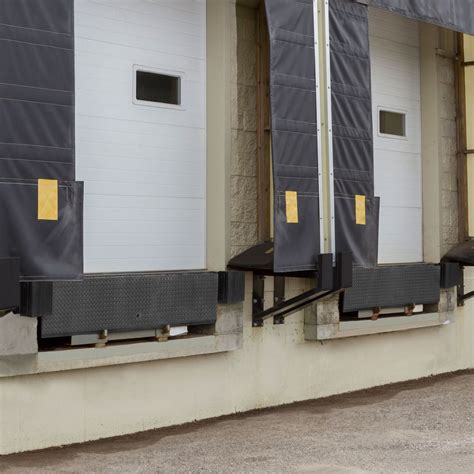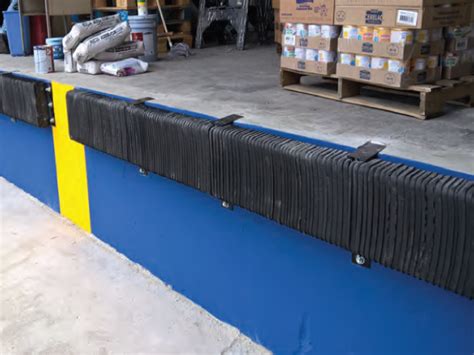When it comes to ensuring the safety and efficiency of loading dock operations, one often overlooked yet crucial component is the loading dock bumper. These bumpers are designed to absorb the impact of trucks and trailers as they back into the dock, protecting the dock, the building, and the equipment from damage. In this article, we will delve into the world of loading dock bumpers, exploring their importance, types, and factors to consider when selecting the right bumper for your loading dock.
Key Points
- Understanding the different types of loading dock bumpers, including molded, laminated, and steel-faced bumpers
- Recognizing the importance of proper bumper installation and maintenance for optimal performance
- Considering factors such as dock height, traffic volume, and trailer type when selecting a loading dock bumper
- Utilizing loading dock bumpers as part of a comprehensive loading dock safety and efficiency strategy
- Ensuring compliance with relevant regulations and standards for loading dock equipment
Types of Loading Dock Bumpers

There are several types of loading dock bumpers available, each with its own unique characteristics and advantages. Molded bumpers, for example, are made from a single piece of molded rubber and are known for their durability and resistance to abrasion. Laminated bumpers, on the other hand, are constructed from layers of rubber and are often used in high-traffic applications. Steel-faced bumpers, as the name suggests, feature a steel face plate and are ideal for use in heavy-duty loading dock environments.
Molded Loading Dock Bumpers
Molded loading dock bumpers are a popular choice due to their simplicity and effectiveness. They are typically made from a durable rubber compound that is resistant to weathering and abrasion. Molded bumpers are also relatively low maintenance, as they do not require the replacement of individual components. However, they can be more expensive than other types of bumpers and may not be suitable for very high-traffic applications.
Laminated Loading Dock Bumpers
Laminated loading dock bumpers are constructed from layers of rubber that are bonded together to form a single unit. This design provides excellent shock absorption and resistance to compression. Laminated bumpers are often used in high-traffic applications, as they can withstand the repeated impact of trucks and trailers. However, they can be more difficult to install and maintain than molded bumpers, as individual layers may need to be replaced over time.
Steel-Faced Loading Dock Bumpers
Steel-faced loading dock bumpers feature a steel face plate that is attached to a rubber or plastic backing. This design provides excellent protection against impact and abrasion, making it ideal for use in heavy-duty loading dock environments. Steel-faced bumpers are also relatively low maintenance, as the steel face plate can be easily replaced if damaged. However, they can be more expensive than other types of bumpers and may require additional structural support to ensure proper installation.
| Type of Bumper | Advantages | Disadvantages |
|---|---|---|
| Molded | Durable, low maintenance, simple installation | More expensive, may not be suitable for high-traffic applications |
| Laminated | Excellent shock absorption, resistant to compression, suitable for high-traffic applications | More difficult to install and maintain, individual layers may need to be replaced |
| Steel-Faced | Excellent protection against impact and abrasion, low maintenance, ideal for heavy-duty environments | More expensive, may require additional structural support, steel face plate may need to be replaced |

Importance of Proper Bumper Installation and Maintenance

Proper installation and maintenance of loading dock bumpers are crucial to ensuring their optimal performance and longevity. Bumpers that are not installed correctly may not provide adequate protection against impact, while bumpers that are not properly maintained may deteriorate over time, reducing their effectiveness. Regular inspection and maintenance of loading dock bumpers can help identify potential issues before they become major problems, reducing downtime and improving overall safety and efficiency.
Installation Considerations
When installing loading dock bumpers, it’s essential to ensure that they are properly aligned and secured to the dock. This may involve anchoring the bumper to the dock or using a specialized mounting system. The bumper should also be installed at the correct height to ensure that it is effective in absorbing impact. Additionally, the surrounding area should be clear of debris and obstacles to ensure safe and efficient operation.
Maintenance Considerations
Regular maintenance of loading dock bumpers is critical to ensuring their optimal performance and longevity. This may involve inspecting the bumper for signs of wear and damage, replacing individual components as needed, and ensuring that the bumper is properly secured to the dock. It’s also essential to keep the surrounding area clear of debris and obstacles to ensure safe and efficient operation.
What is the primary purpose of a loading dock bumper?
+The primary purpose of a loading dock bumper is to absorb the impact of trucks and trailers as they back into the dock, protecting the dock, the building, and the equipment from damage.
What are the different types of loading dock bumpers available?
+There are several types of loading dock bumpers available, including molded, laminated, and steel-faced bumpers. Each type has its own unique characteristics and advantages.
Why is proper installation and maintenance of loading dock bumpers important?
+Proper installation and maintenance of loading dock bumpers are crucial to ensuring their optimal performance and longevity. Bumpers that are not installed correctly or properly maintained may not provide adequate protection against impact, reducing safety and efficiency.
Meta Description: Learn about the importance of loading dock bumpers, types of bumpers available, and factors to consider when selecting the right bumper for your loading dock. Ensure the safety and efficiency of your loading dock operations with our expert insights and guidance. (150 characters)



